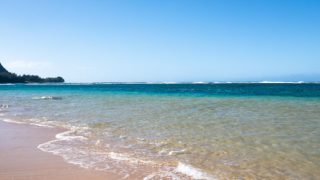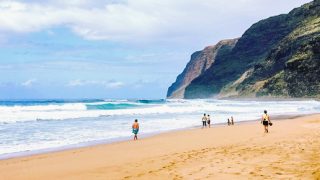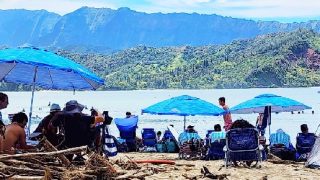If you’ve visited Kauai’s North Shore recently, you already know how Kee Beach works. It’s part of Haena State Park, which requires non-residents to reserve parking or shuttle spots up to 30 days in advance at gohaena.com. Miss that window and you’re usually out of luck, no matter how early you show up. That system, which also governs access to the Kalalau Trail beyond Kee, could soon extend next door to Haena Beach Park. That is a separate county beach that most visitors assume, if for no other reason, due to the name and proximity, is already included.
A proposal now being discussed would shift its management from the County of Kauai to the State, raising strong feelings among both residents and visitors about access, fees, and control. And it’s not just about one beach. This debate is part of a much larger Hawaii story that keeps surfacing island by island: who decides how many visitors come, who benefits from the money they bring, and how far communities should go in restricting what was once open to everyone.
Some residents see state management and reservations as the only way to protect what remains, while others view it as one more loss of local control and the community life that once defined the area.
What is actually being proposed.
The Hanalei-Wainiha-Haena Community Association held an informational meeting on October 14 at the Haena Beach Park Pavilion to discuss a proposed transfer of management from the County of Kauai to Hawaii State Parks. Representatives from the County, State Parks, Hui Makainana o Makana, and the Hanalei Initiative shared details and heard community feedback. If the transfer moves forward, Haena Beach Park would likely be managed in a structure similar to Kee, with visitor caps, paid parking or entry, a resident set-aside, and community stewardship projects funded in part by visitor revenue.
What this means for visitors right now.
For now, nothing changes at Haena Beach Park. Visitors can still drive there, find parking where it’s available, and spend the day much as before. The challenge is that parking around Haena and Tunnels has already become a daily test of patience, with cars lined along the road, limited legal spaces, and frequent enforcement. Doing nothing probably isn’t a long-term option.
If the proposed transfer goes through, Haena could eventually operate more like Kee Beach next door, where reservations, parking limits, and shuttle schedules now govern access. That would make a North Shore day far more predictable for some travelers who value order, while others would miss the freedom of pulling in when the surf looks perfect or the light turns golden at the end of the day. It might also redirect more visitors toward other beaches such as Lumahai and Anini, shifting congestion rather than easing it.
For now, this proposal simply adds one more layer to watch. Visitors planning trips in the months ahead don’t need to change anything yet—but this discussion could hint at what the future of North Shore access may look like.
Quick Take: How Kee’s System Works
Advance reservations required (gohaena.com)
$5 entry fee for non-residents
$10 parking fee for non-residents
Parking spots reserved for Kauai residents
Time slots limit daily visitors
Shuttle option from Waipa ($40 adults 16+, $25 ages 4–15, free under 4)
Note: Access to Limahuli Garden requires arrival by shuttle through gohaena or making a parking reservation up to 30 days in advance with your garden ticket.
The Kee lesson, both good and bad.
Kee is calmer than it was a decade ago, and the land has clearly benefited from fewer cars and better parking management. There is almost always a way for locals to access now, and the area feels less overrun than before. Yet among visitors, reactions remain mixed. One longtime reader wrote that after thirty years of visiting Kauai, she now wakes up at 6 a.m. in Pennsylvania to book a Haena pass and still believes the system is worth it for the order it brings. Others describe it as exhausting, saying it feels like you need a travel agent just to go to the beach.
What people are saying, and what it reveals.
From BOH readers and across the community, the same divide keeps coming up. Many point to the Kee system as proof that structure can work. It brought order where chaos once ruled, reduced traffic, and at the same time gave residents a reliable way to visit without the daily parking stress.
Supporters of Hui Makainana o Makana and the Hanalei Initiative see it as a model that protects fragile places while keeping them accessible for those both aware enough and willing to plan ahead. Some visitors even tell us they now enjoy Kee more because the experience feels calmer and more respectful.
Others see a different story. They say every new shift toward state control means another layer of rules, fees, and distance between Kauai and the people who live here. Many residents express concern that decisions made in Honolulu often overlook what daily life is really like on the North Shore of Kauai. The debate is not only about policy but also about trust, and about whether communities can still shape their own future as more public spaces fall under questionable state management.
Still, whether for or against, most share one hope: that Haena not lose its sense of place. Longtime residents talk about the days of camping and community gatherings under the kamani trees. Visitors wonder how far Hawaii should go in regulating what was once open to all. Both are really asking the same thing. How to protect what is special about this coast without shutting the door on the spirit that made it exactly that way.
The deeper issue: control, trust, and money.
Across Hawaii, popular places are moving from open access to managed access, and that shift always raises the same questions. Who decides? Who benefits? Who pays for stewardship, and who gets to go when a place cannot handle everyone at the same time?
On Maui, Oahu, and the Big Island, reservation systems, fee hikes, and traffic rules are rolling out at more sites, and they create both peace and friction.
The Haena debate is a highly visible part of that statewide pattern, and it is also intensely local. Residents want proof that the money collected at the gate or at the meter stays on Kauai and that it funds real maintenance, safety, and restoration. They also want to know that a partnership protects culture, not just parking lots and bathrooms.
The ripple effects visitors are already feeling.
When one access point tightens, another tends to absorb the overflow. After Kee changed, locals say Lumahai and the stretch around the dry cave often fill fast, and shoulder parking has become a real safety concern. A similar shift at Haena would likely redirect traffic again, meaning even visitors who do not plan to go there could feel the impact. This single park proposal is bigger than it might appear and affects more than one beach. It shapes how the entire North Shore moves and which places remain easy to reach and enjoy without a reservation.
What a compromise could look like.
One idea gaining traction is financial transparency. A quarterly public report could show how much revenue the park generates, how much stays on Kauai, and exactly what it funds. Visitors paying entry or parking fees would know their money supports maintenance, lifeguards, and restoration, not bureaucracy.
Other possible steps include a firm resident set-aside for parking to ease tension, a limited resident-only camping pilot to bring back long-standing traditions, and a family-friendly shuttle plan that serves more than hikers. None of these alone will solve every problem, but together they could protect Haena while keeping access clear and the community engaged.
What happens next, and what to watch.
The initial meeting was designed to gather input, and more opportunities to comment are likely before any transfer is finalized. If the County proceeds, the State Department of Land and Natural Resources would take the lead, likely in partnership with Hui Makainana o Makana and the Hanalei Initiative.
Watch for details on how many parking spaces would be reserved for residents, how the reservation schedule would work, and whether camping returns in any form. Also watch for traffic planning beyond the park itself, since any Haena change will ripple back toward Hanalei Bridge and out to other beaches.
Where this fits in the bigger Hawaii travel conversation.
This story connects directly to other recent coverage about visitor rules and access. Residents across the islands are pushing for limits, clearer fees, and a voice in how tourism is managed, and visitors are deciding whether to accept more planning and cost in return for a calmer experience. That tension powered some of Beat of Hawaii’s most read and most commented stories this year, and Haena sits right in that lane. If you follow our pieces on residents speaking out, visitor fee debates, and the many places that now require reservations, you already understand the stakes. This is Kauai’s latest version, and it will set a tone for what comes next Both on the Garden Island and statewide.
Have you been impacted by prior changes on the North Shore? If you’ve been visiting for years, has the reservation system at Kee made your trips better or just more complicated? Would a similar setup at Haena change your plans entirely, or is this the price of protecting paradise? And if you’re a resident, would you support trading county control for guaranteed parking and the return of local camping?
What happens at Haena Beach Park could reshape beach access across Kauai and set the tone for Hawaii’s approach to tourism management for years to come.
If Haena Beach Park became part of the state system with required reservations like Kee Beach, would that feel like progress or just one beach too many under control?
Get Breaking Hawaii Travel News







We were Wainiha residents for 3 years and been living on Kauai for 7 years total. I absolutely love how Kee beach is managed now. There is always parking for people with state ID and beach is so peaceful and clean and trees and reefs are recovering. Still plenty of hikers are coming through, so access is available with advanced planning. I support turning Haena beach park into state park and I also think that entire stretch from Waipa to Kee needs to become a state park and become regulated. It would solve issues with overflow of cars parked along the road. North Shore Kauai is a national treasure and is to be protected at all cost.
Loved the old Ke’e even with crazy gutted parking lot. Then shuttle from Princeville, $15. Then 3am on website, no help. Now $40? No way. Aloha and Mahalo, Ke’e. Thanks for the memories.
Now it is Belize (Turneffe atoll still has really nice coral) and Sea of Cortez (Mexico) to snorkel with sea lions.
Not sure who wants to pay $40 a person for beach parking, ’cause that’s what this is. But if people are already paying $40 a head just to go to Ke’e, maybe they ought to raise it to $80. Call it a stupid tax.
This will make Lumahai Local an even bigger mess, and no lifeguards. Like another commenter said, may as well put the toll both above Hanalei river bridge, and be done with it.
Please Kauai, remember your lessons of state control of the money produced from taxes, fees etc on your island, and disappear into state coffers. It takes years or decades just to implement needed road safety projects or even painting lines on your roads. The Poipu area is a prime example.
You mention keeping any new fees” At The Gates” in Kauai instead of going into the dumpster of the State auspices. Good luck with that if the State takes control. Keep it local in Kauai.
I agree that people will just go elsewhere. When I stay my 6 months on the island, I don’t go to Kee at all. I don’t want to reserve, pay in advance and then come my time slot it is raining or too cold. I come to Hawaii to chill and go with the flow…not schedule every minute. Maybe Hawaii could have a state park pass one could purchase like they do in many states I have lived in. This pass is a one time fee that grants access to all parks.
Yes, Kee Beach is calmer, but it also adds a level of complexity and increased cost to a trip.
Since it seems that it ultimately will end up this way, instead of creeping restrictions, why not just put a guard shack at the top of the hill at Princeville and restrict entry from there and be done with it.
As for access to Limahuli Garden, I’ve been there several times and yes it does need a reservation, but I have taken the shuttle several times as well and it never has stopped there, nor I believe is it on their stop schedule.
The problem with making beach reservations 30 days in advance is you can’t predict the weather. And there are no refunds allowed. When I was there in July, there were torrential downpours as we waited for the shuttle. It rained off & on all day and was cloudy. Not the best beach day especially when we paid $80 for the 2 of us in advance. Tourists feel taken advantage of in that situation. At least offer a raincheck to standby for another day or refund the fee.
Can I not mention another place this beach can and is welcome to go to?
We have been coming to Kauai for over 20 years and spend about 30 days a year there. Our first trips to Kee Beach the trail were glorious. The crowds were not bad with parking not big deal. Of course, people parking under the trees by the beach, was a very bad idea. Tunnels was always a regular hang out. Over the years parking became more difficult at both but we always seemed to find a spot. Once the new system for Kee went in we stopped going. Tunnels parking became more difficult but we could usually find one. As, fewer areas along the beach side were allowed for parking it became more difficult. Now we will take a drive rarely do we get lucky. We are pretty much giving up. Lumahi and Aninni are the places we go. They are getting crowded and last year with the construction the parking at the Hanalei Bay side of Lumahi was almost non-existent. Clearly, it is a problem. Kauai just has too many visitors! What’s the answer, allow fewer flights? Time slots?
Please help in obtaining 3to4 picnic benches on the grass near the beach sand. West side Poipu Beach park. Nukomi life guard tower area. Only 1 in sad shape remains. The past 7 yrs. 3 benches have broken & been removed, not fixed & replaced. Handicapped especially need tables to enjoy the views & rest. 2 pavilions are there but when large gatherings occupy them, no other tables are available. I’ve contacted parks & rec. yearly & nothing. Maybe more can & bottle 5cent deposit should go to the parks. Mahalo John
Haena Beach Park is one of our favorites after years of visiting Kaua’i. We would welcome a reservation structure modeled after the Ke’e Beach system as long as there is visible improvements such as an upgraded and expanded parking lot and the much needed improvement of the rest room facilities (which at the present time are disgusting and gross with non-existent cleaning).
A new parking area for Tunnels Beach would be nice, but I don’t know how or if that would be possible.